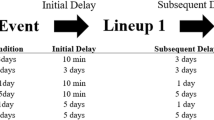Abstract
Witnesses observe crimes at various distances and the courts have to interpret their testimony given the likely quality of witnesses’ views of events. We examined how accurately witnesses judged the distance between themselves and a target person, and how distance affected description accuracy, choosing behavior, and identification test accuracy. Over 1,300 participants were approached during normal daily activities, and asked to observe a target person at one of a number of possible distances. Under a Perception, Immediate Memory, or Delayed Memory condition, witnesses provided a brief description of the target, estimated the distance to the target, and then examined a 6-person target-present or target-absent lineup to see if they could identify the target. Errors in distance judgments were often substantial. Description accuracy was mediocre and did not vary systematically with distance. Identification choosing rates were not affected by distance, but decision accuracy declined with distance. Contrary to previous research, a 15-m viewing distance was not critical for discriminating accurate from inaccurate decisions.
Similar content being viewed by others
References
Brewer, N., & Wells, G. L. (2006). The confidence-accuracy relationship in eyewitness identification: Effects of lineup instructions, foil similarity and target-absent base rates. Journal of Experimental Psychology: Applied, 12, 11–30.
De Jong, M., Wagenaar, W. A., Wolters, G., & Verstijnen, I. M. (2005). Familiar face recognition as a function of distance and illumination: A practical tool for use in the courtroom. Psychology, Crime & Law, 11, 87–97.
Greene, E., & Fraser, S. C. (2002). Observation distance and recognition of photographs of celebrities’ faces. Perceptual & Motor Skills, 95, 637–651.
Harway, N. I. (1963). Judgment of distance in children and adults. Journal of Experimental Psychology, 65, 385–390.
Illinois v Levin 1991, 152 Ill. App. 824.
Kerst, S. M., & Howard, J. H. (1978). Memory psychophysics for visual area and length. Memory & Cognition, 6, 327–335.
Kunnapas, T. (1960). Scales of subjective distance. Scandinavian Journal of Psychology, 1, 187–192.
Lindsay, D. S., Nilsen, E., & Read, J. D. (2000). Witnessing-condition heterogeneity and witnesses’ versus investigators’ confidence in the accuracy of witnesses’ identification decisions. Law & Human Behavior, 24, 685–697.
Lindsay, D. S., Read, J. D., & Sharma, K. (1998). Accuracy and confidence in person identification: The relationship is strong when witnessing conditions vary widely. Psychological Science, 9, 215–218.
Lindsay, R. C. L., Mansour, J. K., Beaudry, J. L., Leach, A. M., & Bertrand, M. I. (in press). Simultaneous and sequential lineups: The problem of eyewitness identification error. Legal & Criminological Psychology.
Loftus, G. R., & Harley, E. M. (2005). Why is it easier to identify someone close than far away? Psychonomic Bulletin and Review, 12, 43–65.
Meissner, C. A., & Brigham, J. C. (2001). Thirty years of investigating the own-race bias in memory for faces: A meta-analytic review. Psychology, Public Policy, & Law, 7, 3–35.
Penrod, S. (2006). Eyewitness guessing and choosing. Paper presented at the meeting of the American Psychology-Law Society, St. Petersburg, FL.
Searcy, J. H., Bartlett, J. C., & Memon, A. (1999). Age differences in accuracy and choosing in eyewitness identification and face recognition. Memory & Cognition, 27, 538–552.
Searcy, J. H., Bartlett, J. C., Memon, A., & Swanson, K. (2001). Aging and lineup performance at long retention intervals: Effects of metamemory and context reinstatement. Journal of Applied Psychology, 86, 207–214.
Stevens, S. S. (1957). On the psychophysical law. Psychological Review, 64, 153–181.
Thorndyke, P. W. (1981). Distance estimation from cognitive maps. Cognitive Psychology, 13, 526–550.
Wagenaar, W. A., & van der Schrier, J. H. (1996). Face recognition as a function of distance and illumination: A practical tool for use in the courtroom. Psychology, Crime & Law, 2, 321–332.
Weber, N., Brewer, N., Wells, G. L., Semmler, C., & Keast, A. (2004). Eyewitness identification and response latency: The unruly 10–12 second rule. Journal of Experimental Psychology: Applied, 10, 139–147.
Wells, G. L., & Lindsay, R. C. L. (1980). On estimating the diagnosticity of eyewitness nonidentifications. Psychological Bulletin, 88, 776–784.
Wiest, W. M., & Bell, B. (1985). Steven’s exponent for psychophysical scaling of perceived, remembered, and inferred distance. Psychological Bulletin, 98, 457–470.
Witmer, B. G., & Kline, P. B. (1998). Judging perceived and transversed distance in virtual environments. Presence, 7, 144–167.
Wright, D. B. (1995). Misinformation methodologies: Explaining the effect of errant information. In G. M. Davies, S. Lloyd-Bostock, M. McMurren, & J. C. Wilson (Eds.), Psychology, law and criminal justice: International developments in research and practice (pp. 39–45). Berlin: De Gruyter.
Author information
Authors and Affiliations
Corresponding author
About this article
Cite this article
Lindsay, R.C.L., Semmler, C., Weber, N. et al. How Variations in Distance Affect Eyewitness Reports and Identification Accuracy. Law Hum Behav 32, 526–535 (2008). https://doi.org/10.1007/s10979-008-9128-x
Received:
Accepted:
Published:
Issue Date:
DOI: https://doi.org/10.1007/s10979-008-9128-x




